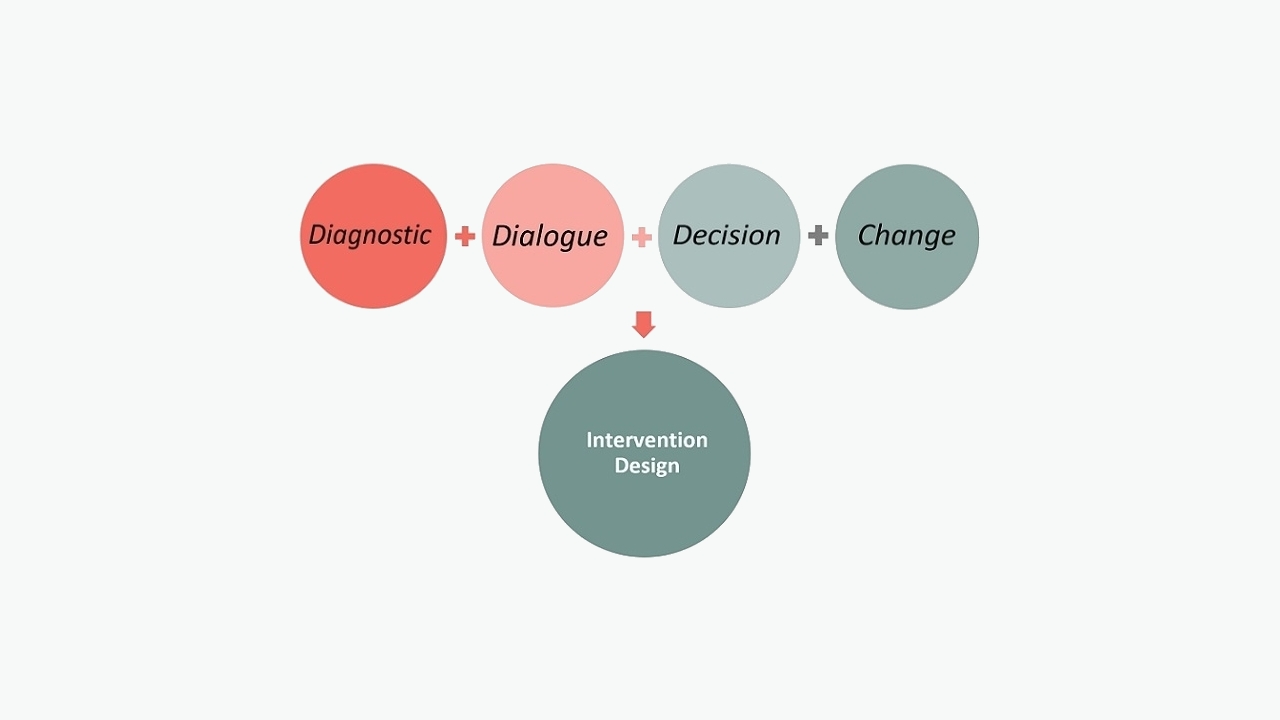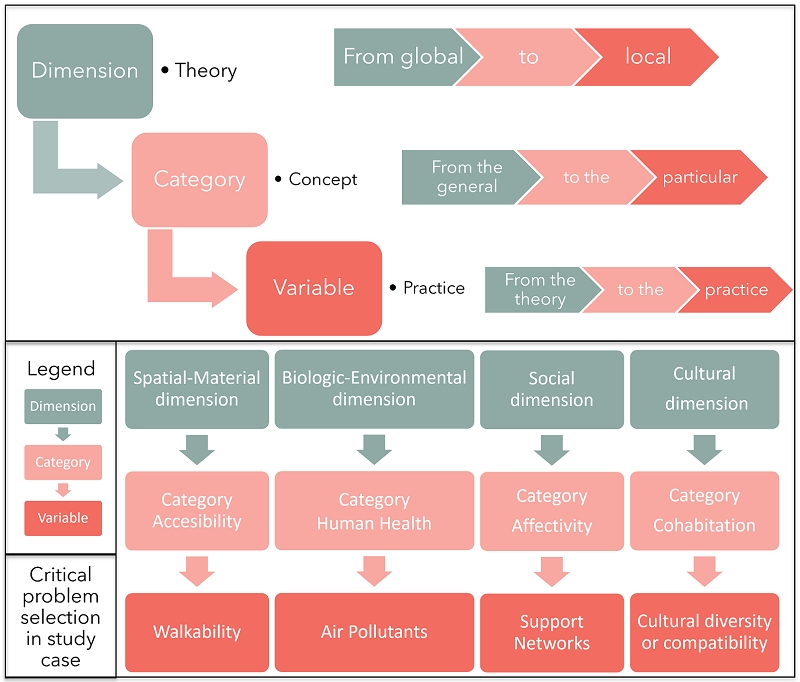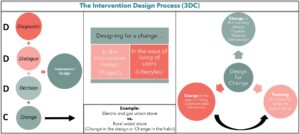
Systemic interventions for complex problems: The Intervention Design Process
By Daniel Marín Vanegas. Originally published on the Integration and Implementation Insights blog.
A Spanish version of this article is available.
What is a useful systemic process for tackling complex societal and environmental problems?
The Intervention Design Process (IDP) is a non-linear approach that integrates different models, methods, techniques, and tools in a set of four iterative stages that are both systematic and systemic (Marín-Vanegas, 2023). The four phases – captured in the acronym IDP-3DC – are:
- Diagnosis
- Dialogue
- Decision
- Change.
This process is elaborated and shown in the figures below.
The process was initially developed in the field of human ecology to investigate complex problems in the built environment and habitat, but is also useful in other areas and contexts where inter- and transdisciplinary collaborative work require systems intervention, and where systems could be of different kinds: spatial-material (as in urban interventions), socio-cultural (as in organizations) or biological-environmental (as in ecosystems).
Intervening in any of these systems can be accomplished by the 4-stage process (3DC) mentioned earlier, with each stage described next. It is important to note that moving through the four stages is iterative, not linear. For example, the dialogue in stage 2 may mean that the diagnosis in stage 1 has to be revisited.
Stage 1: Diagnosis
The diagnosis stage aims to delimit the problems to those that are most critical, by moving from the theoretical dimensions of the relevant systems to practical variables that can be observed in real-world problems and contexts. This is shown in the figure immediately below.
The top section highlights the general principle and provides the colour code for the examples in the bottom section of the figure. In the first hypothetical example, the key issue in the spatial-material system or dimension is “accessibility,” which can be measured using variables for “walkability.”
Diagnosis is an initial step undertaken by the researchers to identify the key issues that are involved in the system, using, for example: content analysis of newspapers, databases, and institutional documents or participant observation for ethnographic fieldwork. From this, the researchers drill down to relevant categories of systems and then variables to study and consider them as constituting the problem as a whole.

Stage 2: Dialogue
Dialogue aims to involve all those who may be experiencing the critical problem identified (who can be referred to as users, stakeholders, actors, or inhabitants). The aim is to socially validate – and, if necessary, adjust – the delimitation undertaken in Stage 1. This requires a flexible, reflective, and open posture to changes.
Both formal and informal dialogue methods can be used. Informal methods include facilitated discussion. Particularly helpful formal methods include citizens’ jury, scenario planning and Delphi technique.
Stage 3: Decision
The challenge in this stage is to consider both interventions and impacts, ie., deciding which intervention is suitable for the context and recognizing the implications of executing it. Even if the diagnosis in Stage 1 is narrowed to one dimension, intervening in that dimension may cause changes (impacts) in the others. This is illustrated in the next figure.
For example, an intervention in the spatial-material dimension can have impacts in the socio-cultural and biological-environmental dimensions. Similarly, an intervention in the communication system can impact all the other dimensions.

Stage 4: Change
The result of iterating through the stages of diagnosis, dialogue, and decision is to implement a proposed solution to the problem, a change. The key aspects are illustrated in the figure below. The left-hand box summarises the Intervention Design Process in its four stages. Diagnosis, Dialogue and Decision lead to a Change implementation and evaluation, using approaches such as theory of change which is described in an i2Insights contribution by Kny and colleagues.
The upper middle box shows that change can be inherent in the intervention design (Project) and/or can require modification in the habits or ways-of-living of users (Lifestyles). For example, if a social housing design selects a stove that is different from that which future inhabitants are used to (ie., a spatial-material intervention), there also needs to be a communicational intervention covering the training of new technologies and cooking practices. An indigenous community moving from a rural habitat to an urban housing project, for instance, may be moving from rural wood stoves (or campfires) to electric or gas stoves. The communicational intervention needs to cover the technology, cooking practices and the necessity to pay bills for the new services.
This point is re-emphasised in the right-hand box of the figure below: the change can be inherent in the intervention (in the housing design or the spatial-material dimension) and/ or it can require a change in how users live (which requires a communicational intervention to provide training for users in acquiring new habits).

The overall goal of the Intervention Design Process is to design for the change across each combination of the dimensions shown in the second figure.
Conclusion
This brief overview of the Intervention Design Process gives some insight into how it can be used for an array of problems and contexts.
Rather than providing a static structure or a rigid process, the Intervention Design Process provides those intervening in complex systems with a framework that allows them to incorporate new categories, dimensions, variables, and relationships.
For which problems would you find this process helpful? Are there dimensions that you think are missing? Are there processes other than diagnosis, dialogue, decision and change that you would include?
To find out more:
This i2Insights contribution is based on:
Marín Vanegas, D. F. (2023a). The Habitat Intervention Design Process, Part II: A Transdisciplinary Model in the Pedagogy of the Design of the Built Environment. The International Journal of Design Education, 17, 2: 155-195. (Online – open access) (DOI): https://doi.org/10.18848/2325-128X/CGP/v17i02/155-195
Relevant background information and the sources for all of the IDP-3DC dimensions can be found in:
Marín Vanegas, D. F. (2023b). The Habitat Intervention Design Process, Part I, Model Foundations: From Ecology to Architecture as an Interdisciplinary Transition. Design Principles and Practices: An International Journal—Annual Review, 16, 1: 53-73. (Online) (DOI): https://doi.org/10.18848/1833-1874/CGP/v16i01/53-73 and (Online – open access): https://www.researchgate.net/publication/368334148
Biography:
 |
Daniel Marín Vanegas is a builder-architect, co-founder of the ‘Construction and Built Environment Sciences’ research group, and an invited advisor for the Curriculum Reform Committee of the Curricular Area of Construction and Habitat at the Colombian National University in Medellin. He is fostering the transition to inter- and transdisciplinary pedagogies in his institution through those curriculum reforms. He is a human ecologist who fosters the vision of technology (built environment) as another type of nature. |
Article source: Systemic interventions for complex problems: The Intervention Design Process. Republished by permission.





